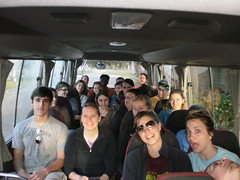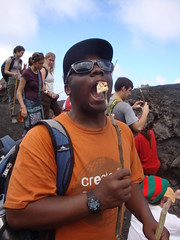 This past week has been a nice chance to settle into the routine of our lives here in Guatemala for the next while. Returning to the houses of our host families every night finally feels a little bit more like home, using the camionetas (public buses) is not as daunting a task as a week ago, and Spanish classes are off to a great start. Every morning we study Spanish for 4 hours, and then after lunch our activities vary from day to day. Here is a glimpse of our weekly schedule:
This past week has been a nice chance to settle into the routine of our lives here in Guatemala for the next while. Returning to the houses of our host families every night finally feels a little bit more like home, using the camionetas (public buses) is not as daunting a task as a week ago, and Spanish classes are off to a great start. Every morning we study Spanish for 4 hours, and then after lunch our activities vary from day to day. Here is a glimpse of our weekly schedule:
Mondays are our free afternoons, a nice chance to email home or catch up on that homework we put off until too late. Tuesdays we take a class (in English) about topics pertinent to life in Guatemala. Last week Professor Héctor Casteñeda took us on a quick trip through Guatemalan history, from the pre-colonial life of indigenous Mayans through the 30 year long civil war to current issues of continued structural oppression. We spend our Wednesday afternoons in worship, prayer and reflection on our experience. Thursdays we take a field trip! This past Thursday we visited the National Cemetery, and then visited the city dump literally right in the cemetery’s back yard. What a contrast between the grand mausoleums of the wealthy, the wall of niches for the poorer, and the poorest working in the landfill in back. Finally, Fridays are a chance to check-in with the larger group to discuss the difficulties of life in another culture and the adventures we have had.
 Our weekends vary, but we usually take a trip somewhere. This past week our destination was nearby Volcán de Pacaya, one of the active volcanoes in the area. The hike confirmed for many of us that perhaps we have been neglecting regular exercise, but the beautiful views certainly made up for it. Unfortunately, for safety reasons, we didn’t encounter any molten lava (in previous years this was a regular occurrence, but since a recent eruption eliminated the path to the rim of the volcano, current tours take a different, safer route), which disappointed some of us. To make up for it, we brought marshmallows and enjoyed a mid-hike snack of volcano-roasted marshmallows. The vents in the ground provided the ideal distribution of heat around the marshmallow, making for perfectly toasted sugary-gooeyness.
Our weekends vary, but we usually take a trip somewhere. This past week our destination was nearby Volcán de Pacaya, one of the active volcanoes in the area. The hike confirmed for many of us that perhaps we have been neglecting regular exercise, but the beautiful views certainly made up for it. Unfortunately, for safety reasons, we didn’t encounter any molten lava (in previous years this was a regular occurrence, but since a recent eruption eliminated the path to the rim of the volcano, current tours take a different, safer route), which disappointed some of us. To make up for it, we brought marshmallows and enjoyed a mid-hike snack of volcano-roasted marshmallows. The vents in the ground provided the ideal distribution of heat around the marshmallow, making for perfectly toasted sugary-gooeyness.
Even though we have a lot of fun climbing volcanoes and applying our developing Spanish skills, this trip is also a sobering one. Almost every day I am reminded, either in class or on a field trip or in an assigned passage I read, of the oppression that is common throughout Latin America, and the gross human-rights violations that have happened and still continue through today. Even more difficult to grapple with is the part that my own country has played in the drama of Latin America. In the words of the late Catholic priest Henri Nouwen, “Looking at the movements of the U.S. from the perspective of this poor, helpless, and dependant country is a quite different experience than looking at it from within the United States”. Though he was writing from his experiences in Bolivia 30 years ago, his words have an eerie applicability to the situation in Guatemala as well. And though the civil war formally ended in 1996, it is difficult to learn that the peace accords are selectively applied, and many Guatemalans still deal with racism and extreme poverty.
We left the border between the United States and Mexico just two weeks ago, and yet here we are in Guatemala, facing even more subtle borders. As we continue to immerse ourselves in the culture here, may we discover how we can cross these borders. Perhaps then we will discover what it means to love our Guatemalan neighbors.
-Brandon Waggy